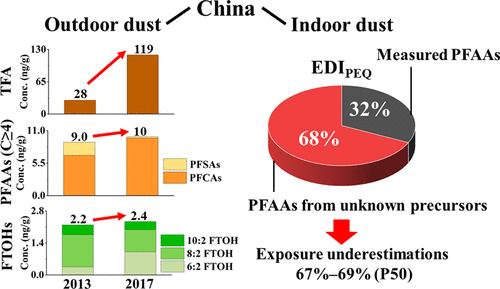当前位置:
X-MOL 学术
›
Environ. Sci. Technol.
›
论文详情
Our official English website, www.x-mol.net, welcomes your feedback! (Note: you will need to create a separate account there.)
Per- and Polyfluoroalkyl Substances in Outdoor and Indoor Dust from Mainland China: Contributions of Unknown Precursors and Implications for Human Exposure
Environmental Science & Technology ( IF 10.8 ) Pub Date : 2021-03-26 , DOI: 10.1021/acs.est.0c08242 Bin Wang 1 , Yiming Yao 1 , Yu Wang 1 , Hao Chen 1 , Hongwen Sun 1
Environmental Science & Technology ( IF 10.8 ) Pub Date : 2021-03-26 , DOI: 10.1021/acs.est.0c08242 Bin Wang 1 , Yiming Yao 1 , Yu Wang 1 , Hao Chen 1 , Hongwen Sun 1
Affiliation

|
Per- and polyfluoroalkyl substances (PFASs) were analyzed in outdoor (n = 101) and indoor dust (n = 43, 38 paired with outdoors) samples across mainland China. From 2013 to 2017, the median concentration of ∑PFASs in outdoor dust tripled from 63 to 164 ng/g with an elevated contribution of trifluoroacetic acid and 6:2 fluorotelomer alcohol. In 2017, the indoor dust levels of ∑PFASs were in the range 185–913 ng/g, which were generally higher than the outdoor dust levels (105–321 ng/g). Emerging PFASs were found at high median levels of 5.7–97 ng/g in both indoor and outdoor dust samples. As first revealed by the total oxidized precursors assay, unknown perfluoroalkyl acid (PFAA)-precursors contributed 37–67 mol % to the PFAS profiles in indoor dust samples. A great proportion of C8 PFAA-precursors were precursors for perfluorooctanesulfonic acid, while C6 and C4 PFAA-precursors were mostly fluorotelomer based. Furthermore, daily perfluorooctanoic acid (PFOA) equivalent intakes of PFAAs (C4–C12) mixtures via indoor dust were first estimated at 1.3–1.5 ng/kg b.w./d for toddlers at high scenarios, which exceeds the derived daily threshold of 0.63 ng/kg b.w./d. from the European Food Safety Authority (EFSA). On this basis, an underestimation of 56%–69% likely remains without considering potential risks due to the biotransformation of unknown PFAA-precursors.
更新日期:2021-03-26












































 京公网安备 11010802027423号
京公网安备 11010802027423号